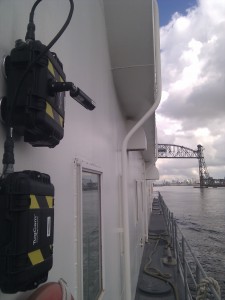 We are excited to announce that The TugCam™ from Netarus was featured in an article in Professional Mariner magazine. The article is titled “TugCam’s remote video camera system allows pilots to see what lies ahead” and is in their December/January 2013 edition. Get your copy of Professional Mariner magazine or read more below.
We are excited to announce that The TugCam™ from Netarus was featured in an article in Professional Mariner magazine. The article is titled “TugCam’s remote video camera system allows pilots to see what lies ahead” and is in their December/January 2013 edition. Get your copy of Professional Mariner magazine or read more below.
TugCam’s remote video camera system allows pilots to see what lies ahead
by Gary Wollenhaupt
When the Norfolk Tug Co. was assigned the job of relocating a couple of three-storytall barges for the U.S. Navy, the company foresaw some potential safety problems. Visibility ahead is always an issue for the crew of a tug pushing barges. But in this case, given the height of the barges, the problem would be acute. From the pilothouse, the crew’s view of the river ahead would be blocked by the tall barges. Norfolk Tug found a solution — a wireless video system called TugCam that effectively allows a tugboat captain to see ahead of the barge he is pushing.
Developed by Netarus, LLC of Norfolk, Virginia, TugCam employs a camera in a magnetically mounted case containing batteries and a transmitter. The camera can be mounted anywhere on a vessel. The wireless receiver in the wheelhouse feeds the TugCam’s remote video camera system allows pilots to see what lies ahead signal from the cameras to any standard video monitor.
Norfolk Tug tested the TugCam system on the Elizabeth River in Norfolk, Va., while moving one of the YRBM (Yard, Repair, Berthing and Messing) barges, which are 146 feet long and can accommodate more than 250 sailors. Capt. W. Hugh McCrory Jr., safety security and compliance manager at U.S. Waterways Transportation LLC, owners of Norfolk Tug, was on the bow of the YRBM barge radioing instructions to the tug operator in the wheelhouse. From there, the operator could watch the video display to see the front
corners of the barge as it navigated past some tight bridge pilings. This was McCrory’s
second experience with the TugCam, and he sees the value in giving the operator a better view.
“The TugCam is good for complex operations like this one. It gives the tug captain a little bit more situational awareness, especially when transiting a bridge,” McCrory said. “It gives the operator a better sense of what’s going on around him. He’s back there (in the
wheelhouse) following orders, but he can’t see if things are going the right way.” The TugCam is to be officially launched at the December 2012 International WorkBoat
Show. Prices start at $4,500 for a basic platform that includes the camera module, batteries and the wireless transmitter and receiver but not a display, said Chris Machut, chief technology officer for Netarus. Users can select options such as multiple cameras, digital video recorders (DVR) and thermal or nightvision cameras as well.
Another option, which right now requires the DVR, is smartphone or tablet access to the
video feed from an iPhone, Android or Blackberry platform. Machut said the company is also developing a system that includes the wireless access point in the TugCam itself,
rather than running through the DVR. The image can also be viewed remotely if there’s an Internet connection on the vessel. The crew can use their smartphones to get
another view of the tow via the camera. “Most deck hands have a Blackberry, Android phone or iPhone, so it’s not an additional expense the company has to take on,” Machut said. “It’s tied into their personal device they’re using anyway.” Another option under development is a remotely operated camera that the operator can pan, tilt and zoom
from the wheelhouse. With two cameras at each corner of the bow, the operator can
have a 270° view ahead and to the sides of the tow. That option will be especially useful in
operations on a curvy waterway like the James River. Norfolk Tug regularly operates boats
on the James between Norfolk and Richmond.
“Sometimes the barge is going out into the turn before the wheelhouse reaches the turn,” Machut said. Machut said the TugCam offers flexibility to meet a tug operator’s operational requirements. A tug operator can install displays on each vessel and then deploy the camera unit where it’s needed. Or each tug could have a unit installed. There’s also a portable display option to make the entire unit portable and easy to set up on any vessel.
“If you have large tows where the bow is over a quarter mile from the wheelhouse, you’ll want to have it on every vessel,” Machut said. “Or if you move project cargos, it’s ideal to have a portable solution and move it between vessels.”
McCrory appreciates the fact the TugCam is easy to set up. “It doesn’t take a
whole lot of time to set up; it’s not going to distract a crewman from other duties they may
have,” he said. From his experience with sea trials of the TugCam, McCrory thinks the addition of video cameras to the wheelhouse will be a good thing for tug operators. “It’s going to give you another tool to keep a proper lookout and I don’t think it will distract you in the wheelhouse if it’s used properly,” he said.
Pick up your copy of Professional Mariner from http://www.professionalmariner.com.

